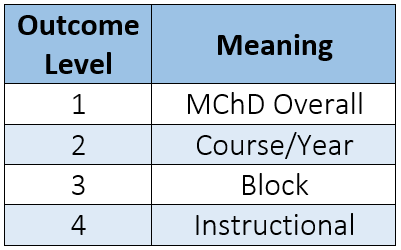Level 3 Learning Outcomes – Block 5 (Digestive Diseases and Nutrition)
Outcome 3.5.1: Describe the anatomy and histology of the gastrointestinal tract and hepatobiliary system and the common associated pathologies.
Outcome 3.5.2: Describe the function of the gastrointestinal tract and hepatobiliary system with emphasis on the processes involved in the digestion and absorption of nutrients, intestinal motility, and metabolic functions of the liver, and explain how disease can affect them.
Outcome 3.5.3: Describe the vascular supply and the endocrine and nervous control of the gastrointestinal tract and hepatobiliary system.
Outcome 3.5.4: Discuss how infection, bleeding, obstruction, perforation and malignancy affect gastrointestinal tract and hepatobiliary system function, and the normal physiological responses to them.
Outcome 3.5.5: Describe how dietary intake can affect health and disease, explain and demonstrate how nutritional status can be determined and discuss how body weight is controlled.
Outcome 3.5.6: Explain the effects of age on nutritional status and on the functions of the gastrointestinal tract and hepatobiliary system in health and disease.
Outcome 3.5.7: Explain the molecular and genetic causation of diseases of the gastrointestinal and hepatobiliary systems.
Outcome 3.5.8: Identify and describe the commensal intestinal microflora, the common gastrointestinal and hepatic viruses, the endogenous and exogenous bacterial pathogens and parasites of the gastrointestinal tract, the organisation and function of the mucosal immune system, and illustrate how to isolate and identify different gastrointestinal pathogens.
Outcome 3.5.9: List the classes and mechanisms of action of drugs used in the treatment of gastrointestinal and hepatobiliary disorders, identify the potential complications associated with the use of medication in liver failure, and identify the common side effects of drug classes (including pain relieving medications) that affect the gastrointestinal and hepatobiliary systems.
Outcome 3.5.10: Plan health promotion strategies for the four major lifestyle factors (nutrition, smoking, alcohol and physical activity) and interpret epidemiological data in understanding the burden and risk factors for major gastrointestinal disease.
Outcome 3.5.11: Describe the ideas and principles that drive collaborative practice so that disciplines working together can improve health outcomes.
Outcome 3.5.12: Define and apply ethical, legal and human rights principles to medical practice from narrow, individual cases, to broader, social examples including inter-professional learning, the standard of care in Emergency Department discharges and good documentation.
Outcome 3.5.13: Apply ethical, legal and human rights principles to medical practice in an integrated way both broadly, generalisable (horizontal integration) and deeply with detailed rationales and justification for action or inaction (vertical integration).
Outcome 3.5.14: Obtain a history from patients whose presenting complaint(s) suggest(s) a disorder of the gastrointestinal system and/or of nutritional status to elucidate the cause of the illness and its impact on well-being and define the biological, social and psychological context of management; demonstrate system specific physical signs and interpret them in physiological and pathological terms; integrate clinical pathology, clinical physiology and imaging investigations with history and physical signs.
Outcome 3.5.15: Further develop clinical reasoning skills in Problem Based Learning cases through the integration of information from lectures, practicals and clinical skills, and consideration of population health and social aspects of disorders of the gastrointestinal tract, hepatobiliary system, and nutritional status.







